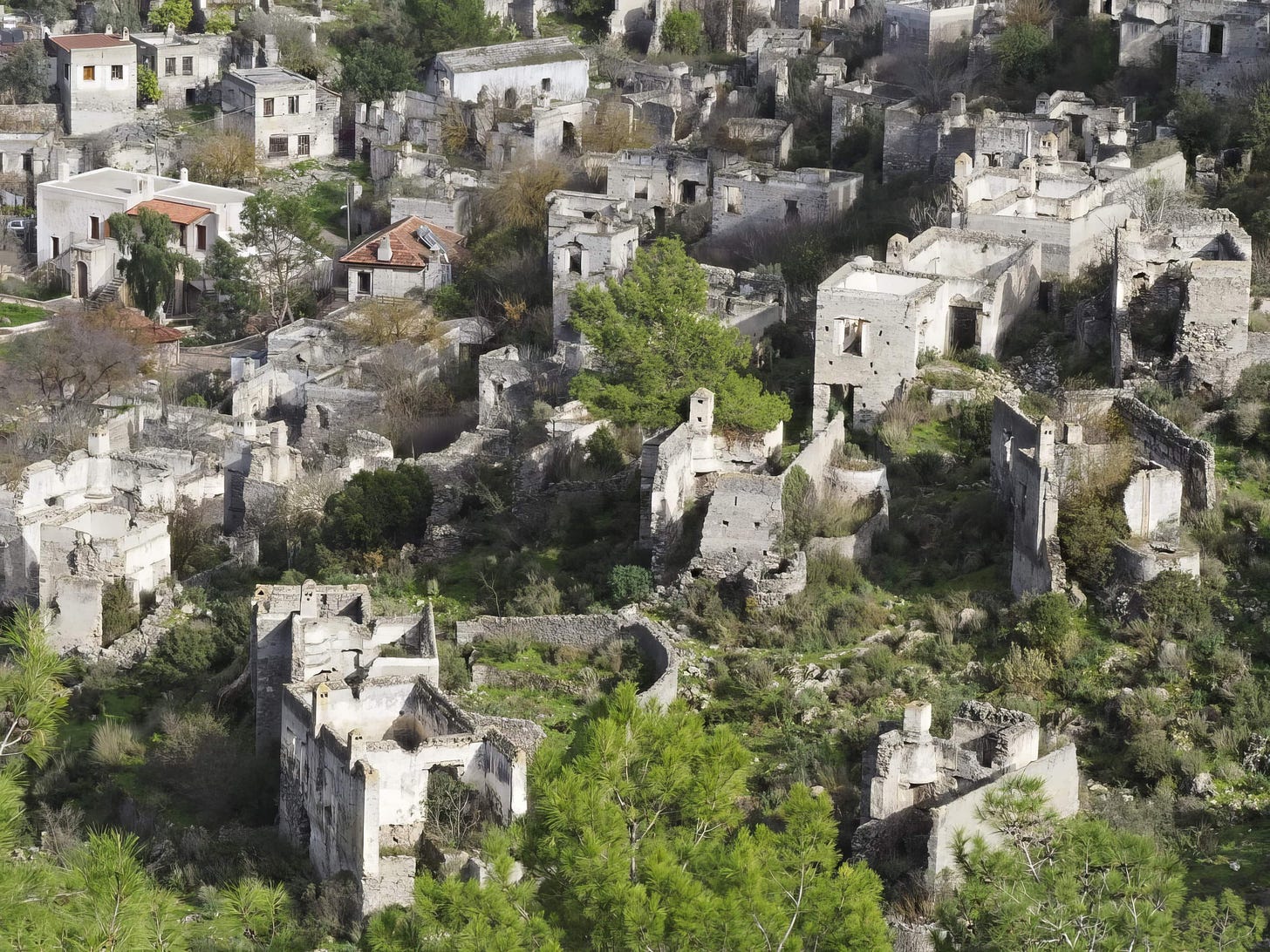January 4, 2022
As I peer out the window of the taksi, tracing the path from the azure shores of Ölüdeniz beach to the time-forgotten village of Kayaköy, the hauntingly vacant ghost town emerges before me.
In the distance, tumbled stones and the vestiges of what was once a thriving community of 10,000 souls sprawl across the hillside. Here, in this unassuming corner of Turkey's western coast, a bygone era lingers in the air.
Established in the 14th century, Kayaköy once thrived as a tapestry of diverse cultures, bound together by an enduring peace.
Alas, the tides of history were unkind, and following the Greco-Turkish War (1919–22), the village was left to the mercy of time, as its inhabitants were uprooted and resettled in a sweeping population exchange.
The goal was clear: to create a monolithic religious identity for both Turkey and Greece, and in doing so, two million lives were irrevocably altered.
The abandoned village of Kayaköy bears witness to this past. When the Greek Muslims from Levissi, Greece (a region now under Turkish control) found themselves in Athens, they chose not to rebuild their lives in Kayaköy, for the hillside village only reminded them of the home they had lost.
Later, in 1957, a devastating earthquake further scarred the village, leaving its houses, schools, chapels, churches, shops, and cafés to the ravages of time and the elements.
As I meander through the rubble-strewn streets, the sound of mid-afternoon prayers reverberates against the cracked stone walls, as if echoing the memories of those who once walked these alleys.
The occasional clank of bells on the collars of sheep and goats grazing nearby adds an eerie soundtrack to the scene.
The crooked cobblestone pathways, now slowly being reclaimed by nature, serve as a reminder that nothing we build can withstand the inexorable march of time.
Tricholoma terreum
The verdant embrace of a pine forest blankets the hilltop behind the village, and as I navigate the brambles, a hidden world of mycological wonders unfurls at my feet.
I marvel at the abundance of Tricholoma terreum, or Grey Knights, nestled amongst the pine needles, only to learn of their potentially lethal effects on the kidneys if consumed frequently and in abundance.
Chroogomphus rutilus
As I continue my exploration, I encounter the striking reddish Chroogomphus rutilus, commonly known as the brown slimecap, copper spike, pine-spikes, or spike-caps.





The genus name is derived from the Greek χρω- chroo-, meaning ‘skin’ or ‘color,’ and ‘γομφος’ gomphos meaning ‘plug’ or ‘large wedge-shaped nail’.
Though visually captivating, these mushrooms are not prized for their culinary virtues. Rather, their firm and chewy texture, coupled with their nondescript flavor, lends them to serve as a versatile addition to various dishes without overpowering the palate.
One food writer states about C. rutilus and C. vinicolor:
“They are excellent when dried, have a firm, chewy texture but almost no flavor. This means you can put them in any dish without worrying about overpowering them – there’s nothing to overpower! They make an excellent textural addition, though, a little crunchy, a little rubbery, very pleasant. Use them in tomato sauce as a meat substitute or in a spicy Thai curry. You can’t go wrong because you can’t taste them.”
Lactarius deterrimus
The mushroom is commonly known as the “false saffron milkcap,” “Orange-latex Milky,” or “orange milkcap.”
The epithet deterrimus is Latin and was chosen by German mycologist Frieder Gröger to highlight the poor gustatory properties of the mushroom, such as the bitter aftertaste and often heavy maggot infestations. The superlative of “dēterior” (meaning less good) means “the worst, the poorest.”
Although the one I found was in pristine condition, after learning about the origin of its name, it didn’t seem appealing to eat. I cut into the stipe and cap of the mushroom to split in two and immediately noticed the orange-salmon color, which over time darkened to a maroon.






Further along the path, trees provide shade, and I feel the damp, cool air leading me further into an area where Peziza cups, Sunburst lichen, and more unidentified species grow. Next to a shrub, a small protuberance grows. It’s an earthball or Scleroderma species. Cut open; it reminds me of dark chocolate (not edible).
In the shadow of this forgotten village, I find myself pondering the culinary heritage of its inhabitants. Did they, too, once forage for mushrooms in these very forests, incorporating the earthy treasures into their meals?
As I descend the hillside, leaving Kayaköy to its ghostly silence, I carry with me the memories of the rich and varied fungal life that thrives in its shadows.












Nature Reclaims: Mushrooms and Memories in Kayaköy's Ghost Town